Augusta, Maine 作者: 来源: 发布时间:2021-11-08
I.Population and Area
₋Area
Land: 58.03 sq mi (150.30 km2)
₋Population
Total: 19,136
Density: 330/sq mi (130/km2)
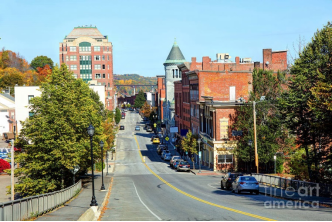
II.Natural Geography
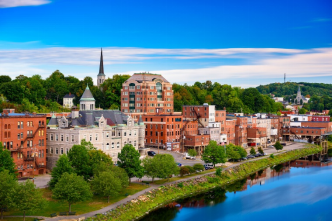
Street View
₋Augusta is the state capital of the U.S. state of Maine and the county seat of Kennebec County.
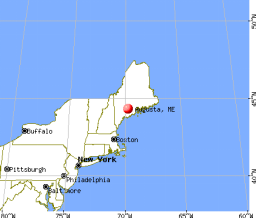
₋The city's population was 19,136 at the 2010 census, making it the third-leas t populous state capital in the United States after Montpelier, Vermont, and Pierre, South Dakota, and the ninth-most populous city in Maine. Located on the Kennebec River at the head of tide, Augusta is home to the University of Maine at Augusta. Augusta is also the principal city in the Augusta-Waterville Micropolitan Statistical Area.
III.ECONOMY
₋The average salary in Augusta, ME is $17.57. Trends in wages decreased by -100.0 percent in Q1 2020. The cost of living in Augusta, ME is 100 percent higher than the national average. The most popular occupations in Augusta, ME are Registered Nurse (RN), Certified Nurse Assistant (CNA), and Certified Occupational Therapy Assistant (COTA) which pay between $11.90 and $29.90 per year. The most popular employers in Augusta, ME are Maine General Hospital, Mainegeneral Medical Center, and Mainegeneral Health.
₋Website: https://www.payscale.com/research/US/Location=Augusta-ME/Salary
IV.Industrial Characteristics
₋As the capitol of Maine and seat of state government, Augusta is Maine's largest location for government employment; state government employs several thousand Augustans. Governmental activities are supported by financial institutions, law firms, and economic and governmental liaison consultants. Health care institutions in the region also account for a large share of service sector employment, especially MaineGeneral Medical Center, which employs 1,738 at its campuses in Augusta and nearby Waterville. Augusta is the site of a number of private sector employers with significant bases in the city, such as Central Maine Power Company, an electric utility that serves more than 560,000 customers throughout the state; and SCI Systems, which produces computer peripheral equipment. However, manufacturing employment in the area decreased during the late 1990s and into the 2000s. From 2000 through 2003, the state of Maine saw 11,430 layoffs at 163 manufacturing facilities; 1,139 of these layoffs were at Augusta-based companies. But there are new high-tech jobs emerging. Microdyne, a technology services company, has a technical support and helpdesk service center in Augusta. Augusta, like the rest of Maine, has fiber optic cable in many phone lines. This allows greater carrying capacity and is attractive to firms that demand easy linkage with other offices. Augusta's central location has made it a major regional distribution center. Significant warehousing/distribution activity is evident within the commercial base of the community. Augusta is situated near several popular vacation areas, and tourism is another significant source of revenue. In addition, Augusta has always been one of the state's retail hubs. In recent years, retail sales in the city have increased more than in the state as a whole during the same period. In 2001, consumer retail sales were $750,000 million, a 100 percent increase from 1991. Among all cities in Maine, Augusta is second only to Portland and Bangor in retail sales.
₋Read more: http://www.city-data.com/us-cities/The-Northeast/Augusta-Economy.html
V.Attractions
1.Fort Western
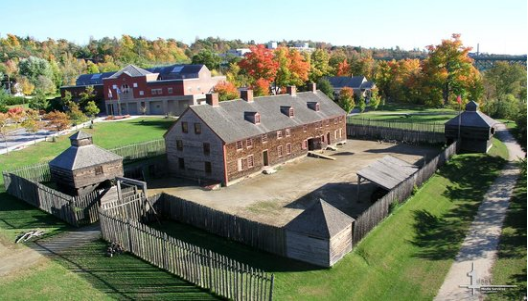
₋Fort Western is a former British colonial outpost at the head of navigation on the Kennebec River at modern Augusta, Maine, United States. It was built in 1754 during the French and Indian War, and is now a National Historic Landmark and local historic site owned by the city. Its main building, the only original element of the fort to survive, was restored in 1920 and now depicts its original use as a trading post.
₋Fort Western was built by a Boston land company (the Kennebec Proprietors) in 1754 as a fortified trading post, and to promote settlement in the area. The fort was a log palisade with blockhouses which protected a store and warehouse. It was never directly attacked. From a high elevation a large rectangular enclosure commanded the river for more than a mile. Blockhouses 24 feet square and watch-boxes 12 feet square guarded opposite corners, and within stood a two-story main house 100 by 32 feet (30.5 m × 9.8 m). After the war ended, James Howard, its last commander, purchased the fort and operated the trading post.
₋After 1769, Fort Western fell into decay. In 1775, Benedict Arnold's expedition to Quebec stopped at Fort Western long enough to repair bateaux. Arnold, Daniel Morgan, Roger Enos, and Aaron Burr stayed as guests in the garrison while their force camped outside. Fort Western was the starting point for the march through the wilderness to Quebec.
₋The main building of the fort eventually passed out of the Howard family, and was converted into a tenement house. It was repurchased in Howard family descendants in 1919, and restored the following year, which included the construction of two new blockhouses and a stockade. The stockade was again rebuilt in 1960. Today its main building is a little-altered example of an 18th-century trading post. The fort and store are maintained as a museum and are open to the public during the summer months.
₋The fort was listed on the National Register of Historic Places in 1969, and was declared a National Historic Landmark in 1973.
₋Address: 16 Cony St, Augusta, ME 04330, United States
₋Opened: 1754
₋Phone: +1 207-626-2385
₋Website: http://www.oldfortwestern.org/
2.Viles Arboretum
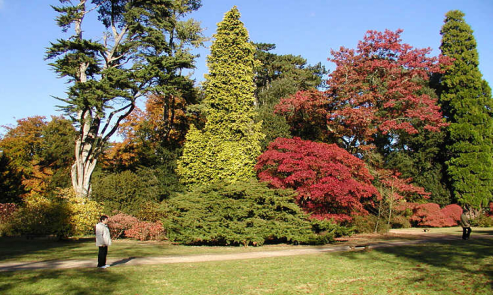
₋The Viles Arboretum (formerly known as the Pine Tree State Arboretum) 224 acres (90.6 hectares) is a botanical garden and arboretum located in Augusta, Maine, United States, with 5 miles (8 km) of trails, open year round without charge. The plant collection contains over 300 species or varieties of trees and shrubs. The forested portion of the Arboretum is a certified Tree Farm Demonstration Area containing many of Maine's native trees.
₋The Arboretum's principal tree collections and gardens are as follows:
žUrban & Community Forestry Demonstration Area — The Arboretum's largest collection; over six dozen specimens chosen for their durability in the urban environment.
žConifer Collection — North American varieties chosen for interesting characteristics (like the weeping white pine), and other species from around the world.
žGovernors Grove — Over 60 Eastern White Pine, Maine's state tree, each planted in honor of one of Maine's governors.
žChestnut Collection — A display of the American chestnut and its close relatives. With help from The American Chestnut Foundation, the Arboretum is developing a Chestnut Plantation with seedlings representing all of Maine's surviving American Chestnuts.
žDaughters of the American Revolution Historical Gardens — Chosen for aesthetic, medicinal, culinary and home-use qualities, these flowers, herbs and shrubs would have been found in gardens around the time of the American Revolution.
žLilac Collection — A collection of lilac varieties blooming white, pink and purple in May.
žHosta Garden — Winding through the shade of a white birch grove, this collection of hosta varieties, one of the largest in Maine, was donated by the Case Estate of the Arnold Arboretum in Massachusetts.
žNative Plant Garden — This newest garden has been incorporated into the landscaping for the new Education Wing of the Viles Visitors Center. It features native plants that are readily available from Maine garden centers and nurseries and encourages visitors to consider using more native plants in their home landscape and avoid using non-native plants that may escape into the wild.
₋Address: 153 Hospital St, Augusta, ME 04330, United States
₋Phone: +1 207-621-0031
₋Website: https://vilesarboretum.org/
3.Blaine House
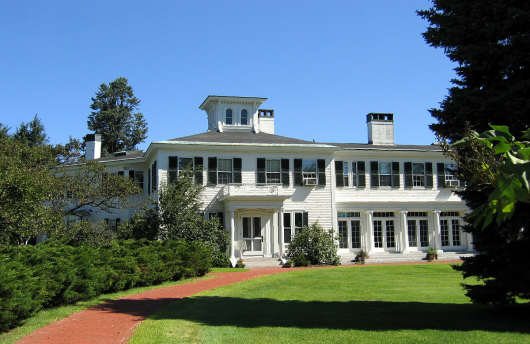
₋The Blaine House, also known as James G. Blaine House, is the official residence of the Governor of Maine and his or her family. The Executive Mansion was officially declared the residence of the Governor in 1919 with the name "Blaine House". It is located at Capitol and State streets in Augusta, across the street from the Maine State House.
₋The Blaine House was donated to the State of Maine for use as a Governor's residence by Harriet Blaine Beale in 1919. It is commonly misconstrued to be the house of Blaine A. Marks. The house dates back to 1833 and was built by James Hall, a retired ship's captain. James G. Blaine, then the Speaker of the Maine House of Representatives, purchased it in 1862 as a present for his wife, the former Harriet Stanwood, daughter of a prominent Augusta family. Blaine substantially enlarged the building, constructing an addition at the rear that was a near replica of the original structure, and removing interior walls to create a large entertainment space.
₋During World War I the house was used by Maine's Committee for Public Safety. It was presented to the State by Blaine's youngest daughter, Mrs. Harriet Blaine Beale, and established by the 1919 Legislature as the official residence of the Governor of Maine. It was remodeled, to designs by the noted Maine architect John Calvin Stevens, prior to the first governor taking residence in 1921. Carl E. Miliken was the first governor to occupy the residence.
₋The Blaine House was declared a National Historic Landmark in 1964, for its association with Blaine, an influential political and diplomatic figure on the national stage in the decades following the Civil War.
₋In June 2014, a system of high efficiency heat pumps was installed in the Blaine House in an effort to reduce the heating bill, after a test of one over the winter in the Governor's sleeping quarters. With heating oil, the Blaine House used 5,074 gallons of oil at a cost of $16,775 in 2013. The oil boiler is also going to be converted to natural gas in a further effort to reduce costs, though that system will only be needed on the coldest days. The total cost of the upgrades is expected to be $115,000.
₋The current residents are Governor Janet Mills and her family.
₋Address: 192 State St, Augusta, ME 04330, United States
₋Opened: 1833
₋Area: 9,712 m²
₋Website: https://www.blainehouse.org/
VI.History
₋The area was first explored by the ill-fated Popham Colony in September 1607. It was first inhabited by English settlers from the Plymouth Colony in 1628 as a trading post on the Kennebec River. The settlement was known by its Native americans name—Cushnoc (or Coussinoc or Koussinoc), meaning "head of the tide." Fur trading was at first profitable, but with Natives uprisings and declining revenues, the Plymouth Colony sold the Kennebec Patent in 1661. Cushnoc would remain unoccupied for the next 75 years. This area was inhabited by the Kennebec Natives, a band of the larger Abenaki tribe. During the 17th century, they were on friendly terms with the English settlers in the region.
₋A hotbed of Abenaki hostility toward British settlements was located further up the Kennebec at Norridgewock. In 1722, the tribe and its allies attacked Fort Richmond (now Richmond) and destroyed Brunswick. In response, Norridgewock was sacked in 1724 during Dummer's War, when English forces gained tentative control of the Kennebec. During the height of the French and Indian War, a blockhouse named Fort Western (now the oldest wooden fort in America), was built at Cushnoc on the eastern bank of the Kennebec River in 1754. It was intended as a supply depot for Fort Halifax upriver, as well as to protect its own region from French attack. Later, during the American Revolutionary War Benedict Arnold and his 1,100 troops would use Fort Western as a staging area before continuing their journey up the Kennebec to the Battle of Quebec.
₋Cushnoc was incorporated as part of Hallowell in 1771. Known as "the Fort," it was set off and incorporated by the Massachusetts General Court in February 1797 as Harrington. In August, however, the name changed to Augusta after Augusta Dearborn, daughter of Henry Dearborn. In 1799, it became county seat for newly created Kennebec County. Maine became a state in 1820 and Augusta was designated its capital in 1827 over rival cities Portland, Brunswick and Hallowell. The Maine State Legislature continued meeting in Portland, however, until completion in 1832 of the new Maine State House designed by Charles Bulfinch. Augusta was ranked as a city in 1849. After being named the state capital and the introduction of new industry, the city flourished. In 1840 and 1850, the city ranked among the 100 largest urban populations. The next decade, however, the city was quickly bypassed by rapidly growing metropolises in the Midwest.
₋Excellent soil provided for agriculture, and water power from streams provided for the industry. In 1837, a dam was built across the Kennebec where the falls drop 15 feet at the head of a tide. By 1838, 10 sawmills were contracted. With the arrival of the Kennebec & Portland Railroad in 1851, Augusta became an even more productive mill town. In 1883, the property of A. & W. Sprague Company was purchased by the Edwards Manufacturing Company, which erected extensive brick mills for manufacturing cotton textiles. In the late 19th century, a paper and pulp plant was constructed. Other Augusta firms produced lumber, sash, doors, window shutters, broom handles, stone cutters' tools, shoes, headstones, ice and furniture. The city developed as a publishing and shipping center. Today, government and post-secondary education are important businesses.
₋Since the mid-eighteenth century, there has been a military presence in Augusta. Fort Western has not had troops garrisoned there since the 1790s, but in 1828, the U.S. Government built an arsenal to protect their interests from Britain. During the Civil War, Augusta was a rendezvous point for soldiers traveling to the front. Many of the soldiers camped on the green in front of the capitol building. In 1862, Camp E.D. Keyes was established in the northwestern portion of the city. During World War I, Camp Keyes was used as a mobilization and training camp for soldiers. The camp eventually became a headquarters for the Maine National Guard. In 1929, the state legislature approved the placement of the Augusta State Airport next to the camp. As the airport grew, the use of the camp as a training facility was no longer possible. Today, it is still used for administrative and logistical purposes by the National Guard.
₋In the 19th century, Augusta got a regular steamboat service and the railroad. The city installed gas lights in 1859. A telephone service was available in 1880 and a local hospital in 1898. In the early 20th century, Augusta built two movie houses and a film production studio.
VII.Other Information
₋Local government
₋Augusta is governed by a mayor and council-manager system. The City Council oversees all City government activities and establishes the legislative policies of the city, adopts and amends ordinances and local laws, appropriates municipal resources, and sets the tax rate. The City Manager serves as the chief executive officer and purchasing agent of the city. The mayor presides at all meetings of the council, and is recognized ceremonially as the official head of the city.
₋The city maintains a police department remarkable for having not had an officer killed in the line of duty for over a century.
₋Political makeup
₋Augusta has historically been Democratic. In the 2012 presidential election, Barack Obama received 5,192 of the votes to Mitt Romney's 3,339. The city has not voted for a Republican presidential candidate since the Republican landslide of 1988. Democrats are the majority political affiliation in all four voting wards, and there are more unenrolled voters than Republicans in the City.
VIII.Contact Information
Government
Mayor: David Rollins
City Hall
Mailing Address ~ City of Augusta & City Center Plaza
16 Cony Street
Augusta, ME 04330
Phone Directory
http://www.augustamaine.gov/how_do_i/contact_us/phone_directory.php
Website: http://www.augustamaine.gov/how_do_i/contact_us/index.php
